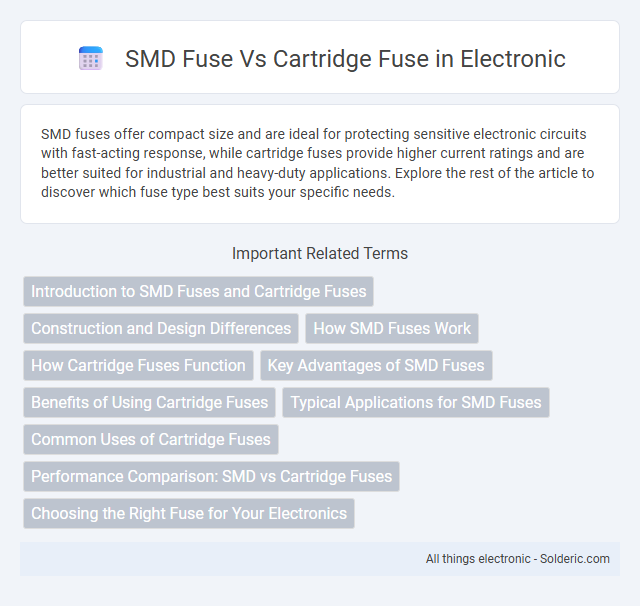SMD fuses offer compact size and are ideal for protecting sensitive electronic circuits with fast-acting response, while cartridge fuses provide higher current ratings and are better suited for industrial and heavy-duty applications. Explore the rest of the article to discover which fuse type best suits your specific needs.
Comparison Table
| Feature | SMD Fuse | Cartridge Fuse |
|---|---|---|
| Form Factor | Surface-mount device, compact and flat | Cylindrical cartridge, bulkier |
| Mounting Type | PCB surface mount | Inline or fuse holder mount |
| Current Rating Range | Typically 50mA to 15A | Wide range: 0.1A to 100A+ |
| Voltage Rating | Up to 125V typically | Up to 600V or higher |
| Interrupting Rating | Lower, suitable for low power circuits | Higher, suitable for high power applications |
| Response Time | Fast-acting or slow-blow options | Available in fast-acting, slow-blow, high-speed types |
| Size and Weight | Small, lightweight | Larger and heavier |
| Applications | Consumer electronics, mobile devices, compact boards | Industrial equipment, power supplies, household circuits |
| Replaceability | Typically replaced by reflow soldering | Easy manual replacement |
| Cost | Generally lower per unit at scale | Varies; often costlier for high ratings |
Introduction to SMD Fuses and Cartridge Fuses
SMD fuses, or Surface-Mounted Device fuses, are compact protection components designed for automated PCB assembly, offering high precision and fast response times in circuit protection. Cartridge fuses are cylindrical, bulkier components typically used in higher current applications, providing robust, replaceable protection for electrical devices and wiring. Both fuse types serve crucial roles in safeguarding circuits, with SMD fuses favored for miniaturized electronic devices and cartridge fuses preferred in industrial and heavy-duty electrical systems.
Construction and Design Differences
SMD fuses feature a compact, surface-mount design suitable for automated PCB assembly, with a low-profile rectangular shape and metal end caps for soldering directly onto circuit boards. Cartridge fuses consist of a cylindrical or tubular body with metal end caps, allowing for easy replacement in fuse holders or clips, making them ideal for higher current applications and robust protection. The primary construction difference lies in SMD fuses being designed for space-saving, high-density electronic circuits, while cartridge fuses emphasize durability and accessibility in traditional electrical systems.
How SMD Fuses Work
SMD fuses protect electronic circuits by quickly interrupting current flow when an overcurrent event occurs, using a thin metal strip embedded in a compact surface-mount package. These fuses respond rapidly to excessive current, preventing damage to sensitive components on your PCB while maintaining a minimal footprint and reliable performance. Their precise construction allows consistent protection in high-density electronic assemblies where space and efficiency are critical.
How Cartridge Fuses Function
Cartridge fuses operate by utilizing a metal wire or filament housed within a cylindrical body that melts when excessive current passes through, interrupting the electrical circuit to prevent damage. The fuse element heats up according to the electrical load, and once the current exceeds the rated value, the filament vaporizes instantly, breaking the circuit. This precise melting point provides reliable protection against overcurrent, making cartridge fuses ideal for high-power applications requiring robust electrical safety.
Key Advantages of SMD Fuses
SMD fuses offer compact size and surface-mount technology compatibility, making them ideal for miniaturized electronic circuits where space saving is crucial. Their rapid response time ensures effective protection against overcurrent, reducing damage to sensitive components and enhancing device reliability. Choosing an SMD fuse can streamline your PCB design with automated assembly processes, improving production efficiency and consistency.
Benefits of Using Cartridge Fuses
Cartridge fuses offer higher current interrupting capacity and enhanced protection for high-voltage applications compared to SMD fuses. They provide easier replacement and better heat dissipation, making them ideal for industrial and automotive environments. Your equipment gains improved safety and reliability by using cartridge fuses to prevent circuit damage during overloads or short circuits.
Typical Applications for SMD Fuses
SMD fuses are commonly used in compact electronic devices such as smartphones, laptops, and wearable technology due to their small size and surface-mount design. Their ability to protect sensitive circuits from overcurrent conditions makes them ideal for automotive electronics, telecommunications equipment, and power supply modules. Choosing the right SMD fuse ensures reliable circuit protection while maintaining the compact form factor of your device.
Common Uses of Cartridge Fuses
Cartridge fuses are commonly used in industrial equipment, electrical panels, and motor protection due to their high current rating and reliable interruption capabilities. They provide effective protection in circuits where space constraints are less critical and higher fault currents need to be safely interrupted. These fuses are preferred in heavy-duty applications such as transformers, power distribution systems, and large electrical machinery.
Performance Comparison: SMD vs Cartridge Fuses
SMD fuses deliver faster response times and are ideal for compact, high-density circuit boards, offering precise overcurrent protection in small electronic devices. Cartridge fuses provide higher current ratings and better durability for industrial applications, capable of handling larger fault currents with greater reliability. Your choice depends on balancing space constraints with performance demands, ensuring optimal protection for specific electrical systems.
Choosing the Right Fuse for Your Electronics
Selecting the right fuse for your electronics depends on factors like size, current rating, and application environment. SMD fuses offer compactness and are ideal for high-density circuit boards, while cartridge fuses provide higher current ratings and better durability in industrial settings. Understanding the electrical load and space constraints ensures optimal protection and longevity for your devices.
SMD Fuse vs Cartridge Fuse Infographic

 solderic.com
solderic.com